Colmar
| |
|---|---|
Prefecture and
commune | |
 Colmar's "Little Venice" | |
| Coordinates: 48°04′54″N 7°21′20″E / 48.0817°N 7.3556°E | |
| Country | France |
| Region | Grand Est |
| Department | Haut-Rhin |
| Arrondissement | Colmar-Ribeauvillé |
| Canton | Colmar-1 and 2 |
| Intercommunality | Colmar Agglomération |
| Government | |
| • Mayor (2020–2026) | Éric Straumann [1] |
| Area 1 | 66.57 km2 (25.70 sq mi) |
| Population (2021)
[2] | 67,730 |
| • Density | 1,000/km2 (2,600/sq mi) |
| Time zone | UTC+01:00 ( CET) |
| • Summer ( DST) | UTC+02:00 ( CEST) |
| INSEE/Postal code |
68066 /68000 |
| Dialling codes | 0389 |
| Elevation | 175–214 m (574–702 ft) (avg. 197 m or 646 ft) |
| 1 French Land Register data, which excludes lakes, ponds, glaciers > 1 km2 (0.386 sq mi or 247 acres) and river estuaries. | |
Colmar ( French: Colmar, pronounced [kɔlmaʁ]; Alsatian: Colmer [ˈkolməʁ]; German: Kolmar) is a city and commune in the Haut-Rhin department and Grand Est region of north-eastern France. The third-largest commune in Alsace (after Strasbourg and Mulhouse), it is the seat of the prefecture of the Haut-Rhin department and of the subprefecture of the Colmar-Ribeauvillé arrondissement.
The city is renowned for its well-preserved old town, its numerous architectural landmarks and its museums, among which is the Unterlinden Museum, which houses the Isenheim Altarpiece.
Colmar is located on the Alsatian Wine Route and considers itself to be the capital of Alsatian wine (capitale des vins d'Alsace).
History
Imperial City of Colmar | |||||||
|---|---|---|---|---|---|---|---|
| 1226–1679 | |||||||
| Status | Imperial City | ||||||
| Capital | Colmar | ||||||
| Common languages | Alsatian | ||||||
| Government | City-state | ||||||
| Historical era | Middle Ages | ||||||
•
Immediacy granted by
Frederick II | 1226 | ||||||
• Joined
Décapole | 1354 | ||||||
| 1673 | |||||||
• Ceded
at Nijmegen | 1679 | ||||||
| |||||||
Colmar was first mentioned by Charlemagne in his chronicle about Saxon wars. [3] This was the location where the Carolingian Emperor Charles the Fat held a diet in 884. [4] Colmar was granted the status of a free imperial city by Emperor Frederick II in 1226. [3] In 1354 it joined the Décapole city league. [5] The city adopted the Protestant Reformation in 1575, long after the northern neighbours of Strasbourg and Sélestat. [6] During the Thirty Years' War, it was taken by the Swedish army in 1632, which held it for two years. In 1634, the Schoeman family arrived and started the first town library. In 1635, the city's harvest was spoiled by Imperialist forces while the residents shot at them from the walls. [7]
The city was conquered by France under King Louis XIV in 1673 and officially ceded by the 1679 Treaties of Nijmegen. [8] In 1854 a cholera epidemic killed many in the city. [6] With the rest of Alsace, Colmar was annexed by the newly formed German Empire in 1871 as a result of the Franco-Prussian War and incorporated into the Alsace-Lorraine province. [9] It returned to France after World War I according to the 1919 Treaty of Versailles, [10] was annexed by Nazi Germany in 1940, and then reverted to French control after the battle of the " Colmar Pocket" in 1945. [11] Colmar has been continuously governed by conservative parties since 1947, the Popular Republican Movement (1947–1977), the Union for French Democracy (1977–1995) and the Union for a Popular Movement (since 1995), and has had only three mayors during that time. [12]
The Colmar Treasure, a hoard of precious objects hidden by Jews during the Black Death, was discovered here in 1863. [13]
Geography
Colmar is 64 kilometres (40 mi) south-southwest of Strasbourg, at 48.08°N, 7.36°E, on the River Lauch, a tributary of the Ill. It is located immediately to the east of the Vosges and connected to the Rhine in the east by a canal.
In 2017 the city had a population of 69,105, [14] and the metropolitan area of Colmar had a population of 199,234 in 2018. [15] Colmar is the centre of the arrondissement of Colmar-Ribeauvillé, which had 211,312 inhabitants in 2017. [14]
Climate
Colmar has an oceanic climate ( Köppen: Cfb) but it is significantly modified by the city's location far inland, with cold, dry winters and warm to hot, wetter summers.
The city has a sunny microclimate and is one of the driest cities in France, with an annual precipitation of just 607 mm (23.9 in), making it ideal for Alsace wine. It is considered the capital of the Alsatian wine region.
The dryness results from the town's location next to mountains, which forces clouds arriving from the west to rise and much of their moisture to condense and fall over the higher ground, leaving the air warmed and dried by the time it reaches Colmar.
The city therefore has more of a continental climate and winter and summer temperatures can sometimes be the lowest or highest in France.
| Town | Sunshine (hours/yr) |
Rain (mm/yr) |
Snow (days/yr) |
Storm (days/yr) |
Fog (days/yr) |
|---|---|---|---|---|---|
| National average | 1,973 | 770 | 14 | 22 | 40 |
| Colmar | 1,780.7 | 606.6 | 25.7 | 24.8 | 55.4 [17] |
| Paris | 1,661 | 637 | 12 | 18 | 10 |
| Nice | 2,724 | 767 | 1 | 29 | 1 |
| Strasbourg | 1,693 | 665 | 29 | 29 | 56 |
| Brest | 1,605 | 1,211 | 7 | 12 | 75 |
| Climate data for Colmar (1981–2010 averages, extremes 1957−present) | |||||||||||||
|---|---|---|---|---|---|---|---|---|---|---|---|---|---|
| Month | Jan | Feb | Mar | Apr | May | Jun | Jul | Aug | Sep | Oct | Nov | Dec | Year |
| Record high °C (°F) | 18.5 (65.3) |
22.7 (72.9) |
27.3 (81.1) |
29.7 (85.5) |
34.7 (94.5) |
38.6 (101.5) |
38.7 (101.7) |
40.9 (105.6) |
33.7 (92.7) |
30.7 (87.3) |
24.0 (75.2) |
20.3 (68.5) |
40.9 (105.6) |
| Mean daily maximum °C (°F) | 4.8 (40.6) |
6.8 (44.2) |
11.9 (53.4) |
16.0 (60.8) |
20.4 (68.7) |
23.7 (74.7) |
26.1 (79.0) |
25.8 (78.4) |
21.4 (70.5) |
15.8 (60.4) |
9.2 (48.6) |
5.5 (41.9) |
15.7 (60.3) |
| Daily mean °C (°F) | 1.7 (35.1) |
2.8 (37.0) |
6.9 (44.4) |
10.4 (50.7) |
14.9 (58.8) |
18.0 (64.4) |
20.2 (68.4) |
19.7 (67.5) |
15.8 (60.4) |
11.3 (52.3) |
5.7 (42.3) |
2.7 (36.9) |
10.9 (51.6) |
| Mean daily minimum °C (°F) | −1.4 (29.5) |
−1.2 (29.8) |
2.0 (35.6) |
4.8 (40.6) |
9.3 (48.7) |
12.3 (54.1) |
14.2 (57.6) |
13.7 (56.7) |
10.2 (50.4) |
6.8 (44.2) |
2.2 (36.0) |
−0.2 (31.6) |
6.1 (43.0) |
| Record low °C (°F) | −22.0 (−7.6) |
−24.8 (−12.6) |
−16.0 (3.2) |
−7.3 (18.9) |
−3.1 (26.4) |
2.1 (35.8) |
4.0 (39.2) |
3.2 (37.8) |
−1.0 (30.2) |
−7.6 (18.3) |
−13.1 (8.4) |
−19.0 (−2.2) |
−24.8 (−12.6) |
| Average precipitation mm (inches) | 31.7 (1.25) |
28.8 (1.13) |
37.4 (1.47) |
44.7 (1.76) |
74.2 (2.92) |
64.2 (2.53) |
66.8 (2.63) |
57.0 (2.24) |
57.8 (2.28) |
56.9 (2.24) |
40.1 (1.58) |
47.7 (1.88) |
607.3 (23.91) |
| Average precipitation days (≥ 1 mm) | 7.1 | 7.0 | 8.5 | 8.9 | 11.2 | 9.6 | 9.4 | 9.1 | 7.9 | 9.3 | 7.3 | 8.5 | 103.9 |
| Average snowy days | 7.0 | 6.2 | 3.6 | 1.1 | 0.0 | 0.0 | 0.0 | 0.0 | 0.0 | 0.0 | 2.7 | 5.1 | 25.7 |
| Average relative humidity (%) | 87 | 82 | 76 | 74 | 75 | 72 | 69 | 72 | 76 | 83 | 87 | 88 | 78.4 |
| Mean monthly sunshine hours | 71.8 | 97.0 | 144.7 | 180.2 | 201.5 | 225.5 | 239.2 | 223.6 | 170.7 | 116.9 | 70.5 | 57.5 | 1,799 |
| Source 1: Météo France [18] [19] [20] | |||||||||||||
| Source 2: Infoclimat.fr (humidity and snowy days, 1961–1990) [21] | |||||||||||||
Population
|
| ||||||||||||||||||||||||||||||||||||||||||||||||||||||||||||||||||||||||||||||||||||||||||||||||||||||||||||||||||
| |||||||||||||||||||||||||||||||||||||||||||||||||||||||||||||||||||||||||||||||||||||||||||||||||||||||||||||||||||
| Source: EHESS [22] and INSEE (1968-2017) [23] | |||||||||||||||||||||||||||||||||||||||||||||||||||||||||||||||||||||||||||||||||||||||||||||||||||||||||||||||||||
Main sights
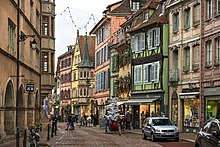
Mostly spared from the destructions of the French Revolution and the wars of 1870–1871, 1914–1918 and 1939–1945, the cityscape of old-town Colmar is homogenous and renowned among tourists. An area that is crossed by canals of the river Lauch (which formerly served as the butcher's, tanner's and fishmonger's quarter) is now called "little Venice" (la Petite Venise).
Architectural landmarks

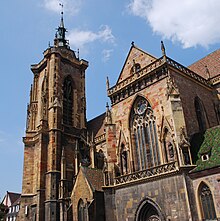



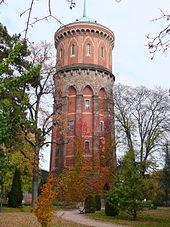
Colmar's secular and religious architectural landmarks reflect eight centuries of Germanic and French architecture and the adaptation of their respective stylistic language to the local customs and building materials (pink and yellow Vosges sandstone, timber framing).
Secular buildings
- Maison Adolph – 14th century (German Gothic)
- Koïfhus, also known as Ancienne Douane – 1480 (German Gothic)
- Maison Pfister – 1537 (German Renaissance).
- Ancien Corps de garde – 1575 (German Renaissance)
- Maison des Chevaliers de Saint-Jean – 1608 (German Renaissance)
- Maison des Têtes – 1609 (German Renaissance)
- Poêle des laboureurs – 1626 (German Baroque)
- Ancien Hôpital – 1736–1744 (French Classicism)
- Tribunal de grande instance – 1771 (French Classicism)
- Hôtel de ville – 1790 (French Classicism)
- Colmar prison – 1791, formerly a convent built in 1316.
- Cour d'Assises – 1840 (French Neoclassicism)
- Théâtre municipal – 1849 (French Neoclassicism)
- Marché couvert – 1865 (French Neo-Baroque). The city's covered market, built in stone, bricks and cast iron, still serves today.
- Préfecture – 1866 (French Neo-Baroque)
- Water tower – 1886. Oldest still preserved water tower in Alsace. Out of use since 1984.
- Gare SNCF – 1905 (German Neo-Baroque)
- Cour d'appel – 1906 (German Neo-Baroque)
Religious buildings
- Église Saint-Martin – 1234–1365. The largest church of Colmar and one of the largest in Haut-Rhin. Displays some early stained glass windows, several Gothic and Renaissance sculptures and altars, a grand Baroque organ case. The choir is surrounded by an ambulatory opening on a series of Gothic chapels, a unique feature in Alsatian churches.
- Église des Dominicains – 1289–1364. Now disaffected as a church, displays Martin Schongauer's masterwork Madonna of the Rose Bower as well as 14th century stained glass windows and baroque choir stalls. The adjacent convent buildings house a section of the municipal library.
- Église Saint-Matthieu – 13th century. Gothic and Renaissance stained glass windows and mural paintings, as well as a wooden and painted ceiling.
- Couvent des Antonins – 13th century. Disaffected church and convent buildings notable for a richly ornate cloister. Now housing the Unterlinden Museum (see below).
- Église Sainte-Catherine – 1371. Disaffected church and convent buildings now used as an assembly hall and festival venue (Salle des Catherinettes).
- Chapelle Saint-Pierre – 1742–1750. Classicist chapel of a former Jesuit college.
- Synagogue – 1843 (Neoclassicism)
Fountains
- Fontaine de l'Amiral Bruat – 1864 (Statue by Bartholdi)
- Fontaine Roeselmann – 1888 (Statue by Bartholdi)
- Fontaine Schwendi – 1898 (Statue by Bartholdi)
Monuments
- Monument du Général Rapp – 1856 (first shown 1855 in Paris. Statue by Bartholdi, his earliest major work)
- Monument Hirn – 1894 (Statue by Bartholdi)
- Statue Les grands soutiens du monde − 1902 (in the courtyard of the Bartholdi Museum)
- Statue of Liberty (Liberty Enlightening the World) replica
Museums


- Unterlinden Museum – one of the main museums in Alsace. Displays the Isenheim Altarpiece, a large collection of medieval, Renaissance and baroque Upper-Rhenish paintings and sculptures, archaeological artefacts, design and international modern art.
- Musée Bartholdi – the birthplace of Frédéric Auguste Bartholdi shows his life and work through paintings, drawings, family objects and furniture as well as numerous plaster, metal and stone sculptures. A section of the museum is further dedicated to the local Jewish community's heritage. [24]
- Musée d'histoire naturelle et d'ethnographie – the zoological and ethnographic museum of Colmar was founded in 1859. Besides a large collection of taxidermied animals, and artefacts from former French and German colonies in Africa and Polynesia, it also houses a collection of ancient Egyptian items.
- Musée du jouet – the town's toy museum, founded 1993.
- Musée des usines municipales – industrial and technological museum in a former factory, dedicated to the history of everyday technology.
- Choco-Story Colmar - museum presenting the history of chocolate, with regional history displays, the ability to taste different chocolates and artworks made of chocolate [25] [26]
Library
The Municipal Library of Colmar (Bibliothèque municipale de Colmar) owns one of the richest collections of incunabula in France, with more than 2,300 volumes. [27] This is quite an exceptional number for a city that is neither the main seat of a university, nor of a college, and has its explanation in the dissolution of local monasteries, abbeys and convents during the French Revolution and the subsequent gift of their collections to the town.
Transport
The small regional Colmar Airport serves Colmar.
The railway station Gare de Colmar offers connections to Strasbourg, Mulhouse, Besançon, Zürich and several regional destinations. Colmar was also once linked to Freiburg im Breisgau, in Germany and on the other side of the Rhine, by the Freiburg–Colmar international railway. However the railway bridge over the Rhine between Breisach and Neuf-Brisach was destroyed in 1945 and never replaced.
Education
|
| This section needs expansion. You can help by
adding to it. (April 2015) |
Senior high schools in Colmar include:
- Lycée Bartholdi
- Lycée Camille Sée
- Lycée polyvalent Blaise Pascal
- Lycée polyvalent Martin Schongauer
- Lycée privé Saint-André
- Lycée professionnel privé Saint-Jean
- École privée Mathias Grunewald
Colmar shares the Université de Haute-Alsace ( Upper Alsace University) with the neighbouring, larger city of Mulhouse. Of the approximately 8,000 students of the UHA, around 1,500 study at the Institut universitaire de technologie (IUT) Colmar, at the Colmar branch of the Faculté des Sciences et Techniques and at the Unité de Formation et de Recherche Pluridisciplinaire d'Enseignement Professionalisé Supérieur (UFR PEPS).
The École Compleméntaire Pour L'Enseignement Japonaise à Colmar (コルマール補習授業校 Korumāru Hoshū Jugyō Kō), a part-time supplementary Japanese school, is held in Colmar. [28] At one time classes were held at the Centre Cultural de Seijo. [29]
Music
Since 1980, Colmar is home to an international summer festival of classical music Festival de Colmar (also known as Festival international de musique classique de Colmar). In its first version (1980 to 1989), it was placed under the artistic direction of the German conductor Karl Münchinger. Since 1989, it is helmed by the Russian violinist and conductor Vladimir Spivakov.
Economy

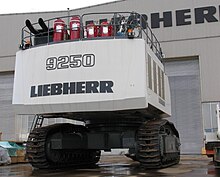
Colmar is an affluent city whose primary economic strength lies in the flourishing tourist industry. But it is also the seat of several large companies: Timken (European seat), Liebherr (French seat), Leitz (French seat), Capsugel France (A division of Pfizer).
Every year since 1947, Colmar is host to what is now considered as the biggest annual commercial event as well as the largest festival in Alsace, [30] the Foire aux vins d'Alsace (Alsacian wine fair).
When Air Alsace existed, its head office was on the grounds of Colmar Airport. [31]
Parks and recreation
By 1991 Lycée Seijo, a Japanese boarding high school in Kientzheim, had established a Japanese cultural center. It housed books and printed materials in Japan and hosted lectures and film screenings. [32]
Notable people
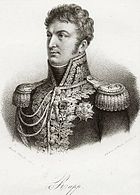


- Caspar Isenmann (1410? – 1484?), painter
- Martin Schongauer (1450–1491), painter and engraver
- Georg Wickram (1502–1562), poet and novelist
- Jean-François Rewbell (1747–1807), diplomat and revolutionist
- Jean Rapp (1771–1821), lieutenant general
- Conrad Berg (1785–1852), composer
- Charles Xavier Thomas (1785–1870), inventor
- Marie Bigot (1786–1820), musician, pianist and composer, friend of Haydn and Beethoven
- Armand Joseph Bruat (1796–1855), admiral
- Georges-Charles de Heeckeren d'Anthès (1812–1895), politician, killer of Alexander Pushkin in a duel
- Auguste Nefftzer (1820–1876), journalist
- Frédéric Auguste Bartholdi (1834–1904), sculptor. He created Liberty Enlightening the World (the Statue of Liberty).
- Camille Sée, (1847–1919), politician
- Jean-Baptiste Lemire (1867–1945), composer
- Jean-Jacques Waltz (1873–1951), drawer and caricaturist
- Ernst Stadler (1883–1914), Alsatian poet
- Paul Wormser (1905–1944), Olympic epee fencer
- Hans Loewald (1906–1993), psychoanalyst and theorist
- Jean-Pierre Muller (1924–2008), Olympic epee fencer
- Bernard Schmitt (economist) (1929–2014), economist and founder of the "Quantum Economics"
- Christian de Chergé (1937-1996), Trappist monk and one of the Tibhirine monks
- Guy Roux (born 1938), football coach
- Pierre Moerlen (1952–2005), musician, drummer and composer
- Pierre Hermé (born 1961), confectioner, entrepreneur and pastry chef
- Thomas Bloch (born 1962), musician
- Éric Straumann (born 1964), politician
- Pascal Elbé (born 1967), actor, director and screenwriter
- Marc Keller (born 1968), football player
- Cendrine Wolf (born 1969), children's author
- Pascal Johansen (born 1979), football player
- Nicolas Armindo (born 1982), racing driver
- Amaury Bischoff (born 1987), football player
- Fabien Schmidt (born 1989), professional cyclist
- Ryad Boudebouz (born 1990), Algerian-French footballer
International relations
Twin towns – sister cities
-
 Schongau, Bavaria, Germany (1962)
Schongau, Bavaria, Germany (1962) -
 Lucca, Italy (1962)
Lucca, Italy (1962) -
 Princeton, United States (1986)
Princeton, United States (1986) -
 Győr,
Hungary (1993)
Győr,
Hungary (1993) -
 Sint-Niklaas, Belgium (1962)
Sint-Niklaas, Belgium (1962) -
 Vale of White Horse, England, United Kingdom (1978)
Vale of White Horse, England, United Kingdom (1978) -
 Eisenstadt, Austria (1983)
Eisenstadt, Austria (1983)
Replicas of historical buildings in Malaysia
Bukit Tinggi Resort Colmar Tropicale which is situated in Bentong district, State of Pahang, Malaysia is a resort-theme historical village inspires from the original Colmar commune in France. Colmar Tropicale located 60 km north-east of Kuala Lumpur.
North of it, a rebuild of Château du Haut-Kœnigsbourg is in the Berjaya Hills, hosting an organic resort hotel. [34]
In popular culture
Colmar's cityscape (and that of neighbouring Riquewihr) served as inspiration for the design of the Japanese animated film Howl's Moving Castle. Scenes in the anime Is the Order a Rabbit? are also based on this location. [35]
See also
References
- ^ "Répertoire national des élus: les maires" (in French). data.gouv.fr, Plateforme ouverte des données publiques françaises. 13 September 2022.
- ^ "Populations légales 2021". The National Institute of Statistics and Economic Studies. 28 December 2023.
- ^ a b "Colmar". Encyclopaedia Britannica. Retrieved 24 June 2019.
- ^ BRAEUNER, Gabriel (2005). Colmar "Un Itinéraire à travers l'Histoire". p. 60. ISBN 9782913302563.
- ^ G. Köbler, Historisches Lexikon der deutschen Länder, 7th edition, C.H. Beck, Munich, 2007.
- ^ a b "The History of Colmar in 20 key dates". Retrieved 25 June 2019.
- ^ Helfferich, Tryntje, The Thirty Years War: A Documentary History (Cambridge, 2009), pp. 290.
- ^ Nathan Prefer (2015). Eisenhower's Thorn on the Rhine: The Battles for the Colmar Pocket, 1944-45. Casemate. p. 18.
- ^ Dan P. Silverman (1971). "The Economic Consequences of Annexation: Alsace-Lorraine and Imperial Germany, 1871-1918". Central European History. 4 (1). Cambridge University Press: 34–53. doi: 10.1017/S0008938900000431. JSTOR 4545591. S2CID 146411340.
- ^ H. Patrick Glenn (1974). "The Local Law of Alsace-Lorraine: A Half Century of Survival". The International and Comparative Law Quarterly. 23 (4). Cambridge University Press: 769–790. doi: 10.1093/iclqaj/23.4.769. JSTOR 758414.
- ^ "From 1918 to 1945 - The inter-war period and hardships time". Retrieved 25 June 2019.
- ^ "Les maires de Colmar depuis la Révolution française". etienne.biellmann.free.fr. Retrieved 24 September 2019.
- ^ Campbell Marian, "Treasures of the plague", September 2007
- ^ a b "Populations légales en vigueur à compter du 1er janvier 2020" (PDF). INSEE. Retrieved 2 January 2020.
- ^ "Aire d'attraction des villes 2020 de Colmar (058)". INSEE. Retrieved 16 June 2022.
- ^ Paris, Nice, Strasbourg, Brest
- ^ "Normales climatiques 1981-2010 : Colmar". www.lameteo.org. Retrieved 15 June 2022.
- ^ "Données climatiques de la station de Colmar" (in French). Meteo France. Retrieved 28 December 2015.
- ^ "Climat Alsace" (in French). Meteo France. Retrieved 28 December 2015.
- ^ "climate of Colmar 1981-2010" (PDF) (in French). Météo-France. Retrieved 15 June 2022.
- ^ "Normes et records 1961-1990: Colmar-Meyenheim (68) - altitude 207m" (in French). Infoclimat. Retrieved 28 December 2015.
- ^ Des villages de Cassini aux communes d'aujourd'hui: Commune data sheet Colmar, EHESS (in French).
- ^ Population en historique depuis 1968, INSEE
- ^ "Un fonds d'art juif trop méconnu". dna.fr. Retrieved 18 August 2016.
-
^
"Choco Story Colmar". Retrieved 20 February 2024.
{{ cite web}}: Check|archive-url=value ( help) - ^ "Chocolate museum of Colmar – My opinion on Choco Story". My Weekend in Alsace. Archived from the original on 20 February 2024. Retrieved 20 February 2024.
- ^ "Welcome to nginx". Archived from the original on 20 July 2011. Retrieved 16 November 2009.
- ^ " 欧州の補習授業校一覧(平成25年4月15日現在)" (). Ministry of Education, Culture, Sports, Science and Technology (MEXT). Retrieved on 10 May 2014. "Chateau Kiener 24, rue de Verdun, 68000 Colmar, FRANCE"
- ^ " 欧州の補習授業校一覧" (). MEXT. 2 January 2003. Retrieved on 7 April 2015. "(学校所在地) Centre Cultural de Seijo 28 rue Schulumberger 68000 COLMAR, FRANCE"
- ^ "History of the Wine fair". Archived from the original on 13 October 2008.
- ^ "World Airline Directory." Flight International. 13 February 1975. 247.
- ^ Iwasaki, Toshio. "Japanese Schools Take Root Overseas." Journal of Japanese Trade & Industry. Japan Economic Foundation (JEF, Kokusai Keizai Kōryū Zaidan), No. 5, 1991. Contributed to Google Books by the JEF. p. 25. "Seijo Gakuen has established a cultural center in the nearby city of Colmar which is used to hold lectures introducing aspects of Japan, to show movies, and to keep books and printed materials oii Japan."
- ^ "Colmar et les villes jumelées". colmar.fr (in French). Colmar. Retrieved 28 March 2021.
- ^ "Schloss-Double : China hat jetzt ein Schlosshotel Neuschwanstein - WELT". DIE WELT. 26 September 2014. Retrieved 22 February 2017.
- ^ "Colmar, France: Home of Gochuumon wa Usagi Desu Ka?". 1 November 2015.




